MOH urged old people and people who have underlying medical conditions to limit social interactions. Still, my supervisor is pushing me to return to the office to work. I've doctor's memo to work from home. Many of my colleagues are working from homes. Tried to talk to MOM and TAFEP but they said they will not interfere into work grievances. Is this the plan to remove someone who has worked for more than 20 years for the company? The bank with the junk logo is a junk?
-
IP addresses are NOT logged in this forum so there's no point asking. Please note that this forum is full of homophobes, racists, lunatics, schizophrenics & absolute nut jobs with a smattering of geniuses, Chinese chauvinists, Moderate Muslims and last but not least a couple of "know-it-alls" constantly sprouting their dubious wisdom. If you believe that content generated by unsavory characters might cause you offense PLEASE LEAVE NOW! Sammyboy Admin and Staff are not responsible for your hurt feelings should you choose to read any of the content here. The OTHER forum is HERE so please stop asking.
You are using an out of date browser. It may not display this or other websites correctly.
You should upgrade or use an alternative browser.
You should upgrade or use an alternative browser.
Covid-19 pandemic - mismanagement by PAP government
- Thread starter LITTLEREDDOT
- Start date
- Joined
- Jul 25, 2008
- Messages
- 13,602
- Points
- 113
Forum: Make sure SafeEntry enforcers are properly trained and equipped
Oct 20, 2021I am disappointed at how the SafeEntry system is being administered in some places.
I was happy when SafeEntry readers were introduced to let us just tap our TraceTogether token, or smartphone with the TraceTogether app open, on the reader to check in or out.
However, I found that whenever the reader failed to respond, the SafeEntry enforcer would ask me to scan the QR code with my TraceTogether app.
This made me think of the primary users for which the token was created - people without smartphones.
I found out later that even if the token's battery is flat, there is a QR code on the token that can be scanned for SafeEntry.
Alas, at many entry points, the enforcer does not have the SafeEntry app loaded onto a mobile device that can scan the token's QR code.
This creates a bottleneck at entry points whenever a person's token cannot be scanned by the readers.
I have also noticed that a few SafeEntry enforcers do not seem to know whether the SafeEntry readers are properly switched on.
Lastly, I wish to share my experience with a SafeEntry enforcer at a market in Chinatown.
He was unmasked when he asked me to check in as he was preparing to eat.
I asked him to put on his mask before I approached the SafeEntry reader, and he grudgingly pulled it on after telling me "you will not die, lah".
To prevent long queues forming at shopping malls now that it is important to check vaccination status as part of SafeEntry, I hope that the malls will ensure their SafeEntry enforcers are properly trained and equipped.
Pauline Margaret Chung Pui Lan
- Joined
- Jul 25, 2008
- Messages
- 13,602
- Points
- 113
Cock-up

The Westlite Jalan Tukang dormitory as seen on Oct 14, 2021.ST PHOTO: GAVIN FOO
Samuel Devaraj
Oct 20, 2021
SINGAPORE - A confluence of factors had led to delays in moving Covid-19-positive workers living in the Westlite Jalan Tukang dormitory to off-site care and recovery facilities, the Migrant Wokers' Centre (MWC) said on Wednesday (Oct 20).
This included disorder in the roll-out of new testing and isolation protocols, logistical and resource challenges in the transfer to care facilities, and an unexpected spike in infections among residents in the dormitory, MWC chairman Yeo Guat Kwang said in a media statement.
The statement came after a team from MWC, accompanied by representatives of the Shipbuilding and Marine Engineering Employees' Union, visited the Jurong dorm last Friday.
Mr Yeo said that most of the workers' concerns regarding newly implemented safe management measures and Covid-19 testing and isolation protocols were resolved within a day after their plight was covered on local media last Thursday.
Among the new measures implemented at dorms since the start of this month are that fully vaccinated workers who test positive for Covid-19 and have no symptoms are to isolate and recover in a dedicated facility within their dormitory for up to 10 days, while workers with symptoms are given a polymerase chain reaction test and sent to a community care facility or hospital depending on their condition.
Mr Yeo said workers whom MWC spoke to confirmed that the authorities "promptly resolved the situation by working with the dormitory operator and employers to rectify the delays and bring order and stability back to the dormitory".
He added: "They also told us that since the improvements were made, the transfer process for Covid-19-positive cases had become more timely, and they hoped that the smoother process would continue."
The dormitory came under the spotlight last week after reports of delays in workers with Covid-19 being sent to care facilities.
Things came to a head when workers gathered en masse to voice their frustrations last Wednesday, and riot police were deployed to the vicinity.
Mr Yeo said a team from MWC and representatives from the union had visited the dormitory to confirm that issues raised were being addressed, to check on the residents' physical and emotional states and to assist them in resolving any lingering, employment or well-being issues.
Though many others had already been moved from the dormitory and many of the remaining residents had not returned from work at the time of the visit, they were able to engage with about 200 migrant workers.
During the visit, Mr Yeo said they learnt that some of the migrant workers did not understand the reasons and strategy behind the new safe management measures and testing and isolation protocols, which might have contributed to the confusion and disorder.
He added that the team has given this feedback to the Ministry of Manpower (MOM) and is working urgently with the ministry "to strengthen the communications and engagement, push out newly developed educational materials in video and print, and translated to the native languages, through our MWC Ambassador Network (made up of senior migrant workers within the same workplaces and living places) and social media channels".
Mr Yeo said that through the ambassadors and other communication channels, including MWC's 24-hour helpline, it will also be monitoring the situation on the implementation of the new protocols and will surface any other irregularities or delays immediately for MOM's attention.
Pictures of food that workers were given that was spoilt or contained insects had been circulated online, and Mr Yeo said MWC understands that the authorities are investigating the matter.
He added that though the MWC team and union representatives were not able to meet anyone who encountered such food, many of the workers they spoke to said there were sometimes issues with the timeliness and quantity of the meals provided to them prior to Oct 13, and new controls put in by the authorities and employers ensured that these issues had been rectified since then.
Migrant workers had told the team that more could be done to ensure that the catered food meets the tastes and dietary preferences of the workers, especially those from China.
Westlite Jalan Tukang residents believed to be Covid-19 positive in their beds
As those coming China have a wide range of dietary preferences based on where they are from, Mr Yeo said it can sometimes take time to reach the optimal catering arrangements for them, and while this was explained to the workers, they were told that it is an endeavour that the employer must do right.
"We repeated to the Chinese migrant workers that their employer had committed to put more attention and resources into working out the most optimal dietary preference solutions as soon as possible and reassured them that we too would continue to monitor the progress of this aspect," Mr Yeo.
Mr Yeo added his team was told that up until the week before Oct 13, the Chinese workers were able to make online purchases of more familiar Chinese sundries, groceries and rations unobtainable from the dormitory's on-site minimart, which would be delivered to them in the dormitory and allow them to supplement their catered food with more familiar dietary options.
The workers explained that these deliveries to the dormitory were stopped a week earlier, ceasing this self-help option, and accentuating the less-than-optimal catering situation.
Workers at Jurong dorm allege neglect, frustrated with lack of medical care for Covid-19
MWC reflected to the employers and dormitory management to restart the deliveries into the dormitory, and Mr Yeo said the dormitory residents appreciate the return of this additional service.
Mr Yeo also said that the engagement also raised certain concerns some migrant workers had regarding their workplace environment.
These were recorded and sent to the employers so that steps may be taken to create a safer and more conducive work environment for all workers.
MWC did not say what these concerns were.
"We understand that the employers are implementing some measures in response to our feedback," he said.
"As with the other feedback we have given to the various stakeholders, we will also continue to monitor these new measures, as well as the sentiment and condition of the migrant workers in response."
Mr Yeo also thanked welfare and corporate organisations that have stepped forward to donate sundries and provisions to the workers, as well as members of the public for their care and concern.
He said: "Having visited the dormitory to observe the mood and situation amongst the residents, as well as engage with them directly, we can update that the situation has been stabilised, with the key concerns of the workers having also been addressed or in the process of being rectified.
Well-wishers who wish to contribute towards supporting the needy or distressed migrant workers in general, can do so via this website.
Some disorder in roll-out of Covid-19 testing, isolation protocols at Jalan Tukang dormitory: MWC chairman

The Westlite Jalan Tukang dormitory as seen on Oct 14, 2021.ST PHOTO: GAVIN FOO
Samuel Devaraj
Oct 20, 2021
SINGAPORE - A confluence of factors had led to delays in moving Covid-19-positive workers living in the Westlite Jalan Tukang dormitory to off-site care and recovery facilities, the Migrant Wokers' Centre (MWC) said on Wednesday (Oct 20).
This included disorder in the roll-out of new testing and isolation protocols, logistical and resource challenges in the transfer to care facilities, and an unexpected spike in infections among residents in the dormitory, MWC chairman Yeo Guat Kwang said in a media statement.
The statement came after a team from MWC, accompanied by representatives of the Shipbuilding and Marine Engineering Employees' Union, visited the Jurong dorm last Friday.
Mr Yeo said that most of the workers' concerns regarding newly implemented safe management measures and Covid-19 testing and isolation protocols were resolved within a day after their plight was covered on local media last Thursday.
Among the new measures implemented at dorms since the start of this month are that fully vaccinated workers who test positive for Covid-19 and have no symptoms are to isolate and recover in a dedicated facility within their dormitory for up to 10 days, while workers with symptoms are given a polymerase chain reaction test and sent to a community care facility or hospital depending on their condition.
Mr Yeo said workers whom MWC spoke to confirmed that the authorities "promptly resolved the situation by working with the dormitory operator and employers to rectify the delays and bring order and stability back to the dormitory".
He added: "They also told us that since the improvements were made, the transfer process for Covid-19-positive cases had become more timely, and they hoped that the smoother process would continue."
The dormitory came under the spotlight last week after reports of delays in workers with Covid-19 being sent to care facilities.
Things came to a head when workers gathered en masse to voice their frustrations last Wednesday, and riot police were deployed to the vicinity.
Mr Yeo said a team from MWC and representatives from the union had visited the dormitory to confirm that issues raised were being addressed, to check on the residents' physical and emotional states and to assist them in resolving any lingering, employment or well-being issues.
Though many others had already been moved from the dormitory and many of the remaining residents had not returned from work at the time of the visit, they were able to engage with about 200 migrant workers.
During the visit, Mr Yeo said they learnt that some of the migrant workers did not understand the reasons and strategy behind the new safe management measures and testing and isolation protocols, which might have contributed to the confusion and disorder.
He added that the team has given this feedback to the Ministry of Manpower (MOM) and is working urgently with the ministry "to strengthen the communications and engagement, push out newly developed educational materials in video and print, and translated to the native languages, through our MWC Ambassador Network (made up of senior migrant workers within the same workplaces and living places) and social media channels".
Mr Yeo said that through the ambassadors and other communication channels, including MWC's 24-hour helpline, it will also be monitoring the situation on the implementation of the new protocols and will surface any other irregularities or delays immediately for MOM's attention.
Pictures of food that workers were given that was spoilt or contained insects had been circulated online, and Mr Yeo said MWC understands that the authorities are investigating the matter.
He added that though the MWC team and union representatives were not able to meet anyone who encountered such food, many of the workers they spoke to said there were sometimes issues with the timeliness and quantity of the meals provided to them prior to Oct 13, and new controls put in by the authorities and employers ensured that these issues had been rectified since then.
Migrant workers had told the team that more could be done to ensure that the catered food meets the tastes and dietary preferences of the workers, especially those from China.
Westlite Jalan Tukang residents believed to be Covid-19 positive in their beds
As those coming China have a wide range of dietary preferences based on where they are from, Mr Yeo said it can sometimes take time to reach the optimal catering arrangements for them, and while this was explained to the workers, they were told that it is an endeavour that the employer must do right.
"We repeated to the Chinese migrant workers that their employer had committed to put more attention and resources into working out the most optimal dietary preference solutions as soon as possible and reassured them that we too would continue to monitor the progress of this aspect," Mr Yeo.
Mr Yeo added his team was told that up until the week before Oct 13, the Chinese workers were able to make online purchases of more familiar Chinese sundries, groceries and rations unobtainable from the dormitory's on-site minimart, which would be delivered to them in the dormitory and allow them to supplement their catered food with more familiar dietary options.
The workers explained that these deliveries to the dormitory were stopped a week earlier, ceasing this self-help option, and accentuating the less-than-optimal catering situation.
Workers at Jurong dorm allege neglect, frustrated with lack of medical care for Covid-19
MWC reflected to the employers and dormitory management to restart the deliveries into the dormitory, and Mr Yeo said the dormitory residents appreciate the return of this additional service.
Mr Yeo also said that the engagement also raised certain concerns some migrant workers had regarding their workplace environment.
These were recorded and sent to the employers so that steps may be taken to create a safer and more conducive work environment for all workers.
MWC did not say what these concerns were.
"We understand that the employers are implementing some measures in response to our feedback," he said.
"As with the other feedback we have given to the various stakeholders, we will also continue to monitor these new measures, as well as the sentiment and condition of the migrant workers in response."
Mr Yeo also thanked welfare and corporate organisations that have stepped forward to donate sundries and provisions to the workers, as well as members of the public for their care and concern.
He said: "Having visited the dormitory to observe the mood and situation amongst the residents, as well as engage with them directly, we can update that the situation has been stabilised, with the key concerns of the workers having also been addressed or in the process of being rectified.
Well-wishers who wish to contribute towards supporting the needy or distressed migrant workers in general, can do so via this website.
I'm really, really really desperate now. My doctor has advised me to WFH because of my underlying medical conditions. He has given me a memo to pass to my boss. From newspaper, we read that many fully vaccinated deaths because of medical conditions. Some died as young as 21 years old. Previously, my boss had given me "hell" even though I had explained with doctor's written advice. Indeed, I'm mentally tortured to the neck. I'm seriously contemplating to hang my neck. I've seek professional counselling but they didn't help much because they could only listen. I've asked MOM and TAFEP for help but they said they will not interfere into employment grievances. I have asked for a re deployment but my boss upfront rejected me. I don't think I'm an isolated case and we are really helpless. We need jobs to provide for our family and our daily needs. We're left with no choice. Previously, we took our chances to get ourselves vaccinated even though we were worried about our medical conditions. Now, we are left with the choice either to expose ourselves to the risks of virus and jobs. Either we return to office to work or we have to resign. We've worked for more than 15 to 20 years for the companies, our contributions are well recognised. Hence, our companies do not terminate us without valid reasons. But, they are pushing us with these underhand methods. If you have read this until now, I know I've won your empathy. I know that you may not help me because professional counsellors like SOS, MOM and TAFEP cannot help us. I think you can help to empathise with me and pray for us. Thank you.
- Joined
- Jul 10, 2008
- Messages
- 35,632
- Points
- 113
Keep the faith, stay well and stay safe.I'm really, really really desperate now.
- Joined
- Jul 25, 2008
- Messages
- 13,602
- Points
- 113
Forum: Issues with address when dining out
NOV 19, 2021
Parents' long-term visit passes have no address
Now that Covid-19 restrictions have been relaxed to allow up to five fully vaccinated persons from the same household to dine out together, my family took my parents out to a neighbourhood restaurant recently.However, we were not aware that my parents' long-term visit passes have no address printed on them, and had a hard time trying to prove that they live under the same roof as us. Unfortunately, we could not convince the restaurant of this, and my aged parents were told to dine separately or we all had to leave. What was to be a happy night out turned out to be a nightmare.
Out of desperation, I went to a police station for help to print our address to use together with my parents' long-term passes but was referred to the Immigration and Checkpoints Authority (ICA).
At ICA, an officer told me to refer the matter to the Ministry of Health, but did not explain why addresses are not shown on the passes.
I don't think I'm the only person facing this problem.
Lim Cheng Kooi
- Joined
- Jul 25, 2008
- Messages
- 13,602
- Points
- 113
Forum: VTL scheme procedures were frustrating
Jan 7, 2022
I recently returned to Singapore via a vaccinated travel lane (VTL) flight from the United States.
While I am very happy that the Government has allowed travellers like me to fly back to see our families, the procedures can be very frustrating.
Due to the differences in conventions for names and dates between the US and Singapore, the Immigration and Checkpoints Authority (ICA) website could not accept my vaccination QR code from the US.
Since the website allows me to file a declaration only three days before the flight, and inquiries are typically responded to in about five days, there was no way to seek rectification in time.
Moreover, calling the SafeTravel helpline was useless as it was automated with no one to speak to, and repeated information that could already be found online.
At the airport, even though I had received an e-mail acknowledging my health declaration, the immigration officer said that it was not in the system and that I would have to redo it and queue again.
It would have been better if provisional acceptance of the materials could be done on the ICA website, so that any problems could be flagged in advance and officers know what needs to be manually reviewed.
This would avoid the need to have an immigration officer review all the materials and slow the arrival process down.
Another issue I ran into is that some instructions received were contradictory. For example, the e-mail acknowledgement I received included a stay-home notice attachment as I was coming from a high-risk country, but the e-mail also said that stay-home notice is not applicable if VTL conditions are met.
I had to read it several times and cross my fingers that I wasn't doing anything wrong.
I hope many others after me can have a better experience with the VTL flight scheme.
Lee Kok Kiong
- Joined
- Jul 25, 2008
- Messages
- 13,602
- Points
- 113
Forum: Hospital could have helped patient's family with vaccine injury aid programme
JAN 12, 2022
I refer to the article, "296 qualified for govt financial aid due to serious side effects" (Jan 8).
My mother was hospitalised with a blood clot and skin problems from Sept 13 to 20 last year, three days after she received her second dose of the Covid-19 vaccination. She is still receiving treatment.
The family was told that this may have been caused by her vaccination.
When I received the bill, I e-mailed the hospital in October asking if my mother could be compensated under the Vaccine Injury Financial Assistance Programme (Vifap).
Despite a reminder sent in November, I have to date not received a response from the hospital.
The hospital could at least have directed me to the correct authority to make my claim.
Janis Goh
- Joined
- Jul 25, 2008
- Messages
- 13,602
- Points
- 113
Only 112 out of 2,200 coffee shops and canteens allow groups of up to 5 to dine in
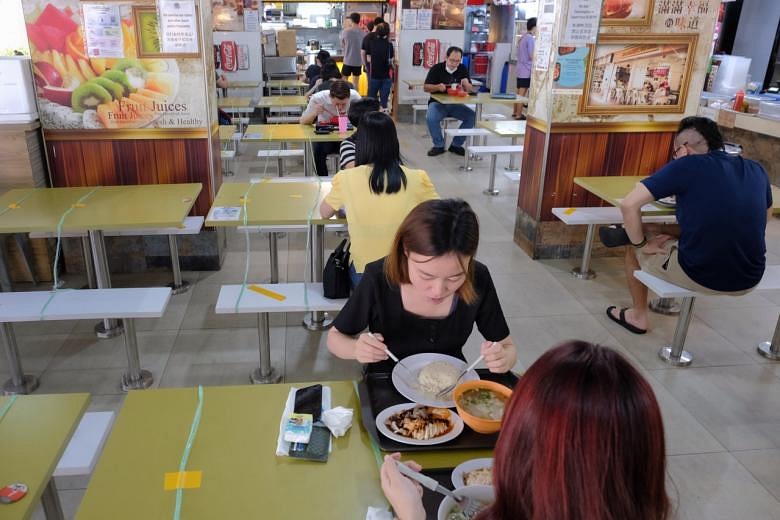
Diners at 206 Management Food Court in Toa Payoh on Jan 14, 2022. The coffee shop allows dining for only two people. ST PHOTO: THADDEUS ANG

Adeline Tan
Jan 14, 2022
SINGAPORE - Even though 2,200 coffee shops and canteens in Singapore can allow up to five fully vaccinated customers to dine in a group, only 112 of them, or about 5 per cent, choose to do so.
Coffee shop associations and stallholders said on Friday (Jan 14) that they are put off by the high cost of implementing vaccination status checks, which can cost them at least a few thousand dollars each month.
In contrast, almost all of the 110 hawker centres managed by the National Environment Agency (NEA) or NEA-appointed operators allow groups of up to five people to eat together. Hawkers do not have to foot the cost of implementing such checks as it is borne by the Government.
Logistical challenges, such as having to consider the layout of the coffee shop when cordoning off certain areas, are another obstacle.
Since Nov 23, coffee shops with the necessary control measures can allow groups of up to five fully vaccinated people to dine in.
To do so, they must control access by cordoning off areas and have dedicated entry points. At these entry points, they must check the vaccination status of all patrons, and differentiate those who are fully vaccinated and are dining in.
They also have to put up posters informing diners that only fully vaccinated people can dine in groups of up to five.
Mr Hong Poh Hin, vice-chairman of the Foochow Coffee Restaurant and Bar Merchants Association, said many of the larger coffee shops have indoor and outdoor seating areas usually separated by a corridor or a walkway, which is also used by residents in the neighbourhood.
As coffee shops are not allowed to seal off these common areas, they must cordon off their indoor and outdoor areas separately, and station someone at each of these entrances. Hiring one person would cost them about $2,000 a month.
Mr Hong said: "Some of the coffee shop operators would want to pass on some of the cost to their stallholders. But not all stallholders would agree because the zi char stalls would benefit the most from larger groups."
But these larger groups, such as families, tend to patronise the coffee shops only on weekends. Many operators feel that the uptick in business does not justify the additional cost, Mr Hong said.
His association represents about 400 coffee shops.
For coffee shops with very popular stalls, barricading the indoor seating area would also be difficult as queues for such stalls can sometimes extend beyond the area.
Mr Kenneth Lee, vice-chairman of Kheng Keow Coffee Merchants Restaurant and Bar Owners Association, said: "Covid-19 is not something that will last for a month or two. We don't know when the pandemic is going to end. So in the long run, all these extra costs will add to our operating expenses.
"Sooner or later, the operators and stallholders will not be able to absorb them and we will have to pass them down to consumers."
Coffee shops also run the risk of getting fined or suspended if safe management measures are breached. Enforcement action may be taken against diners or operators, or both.
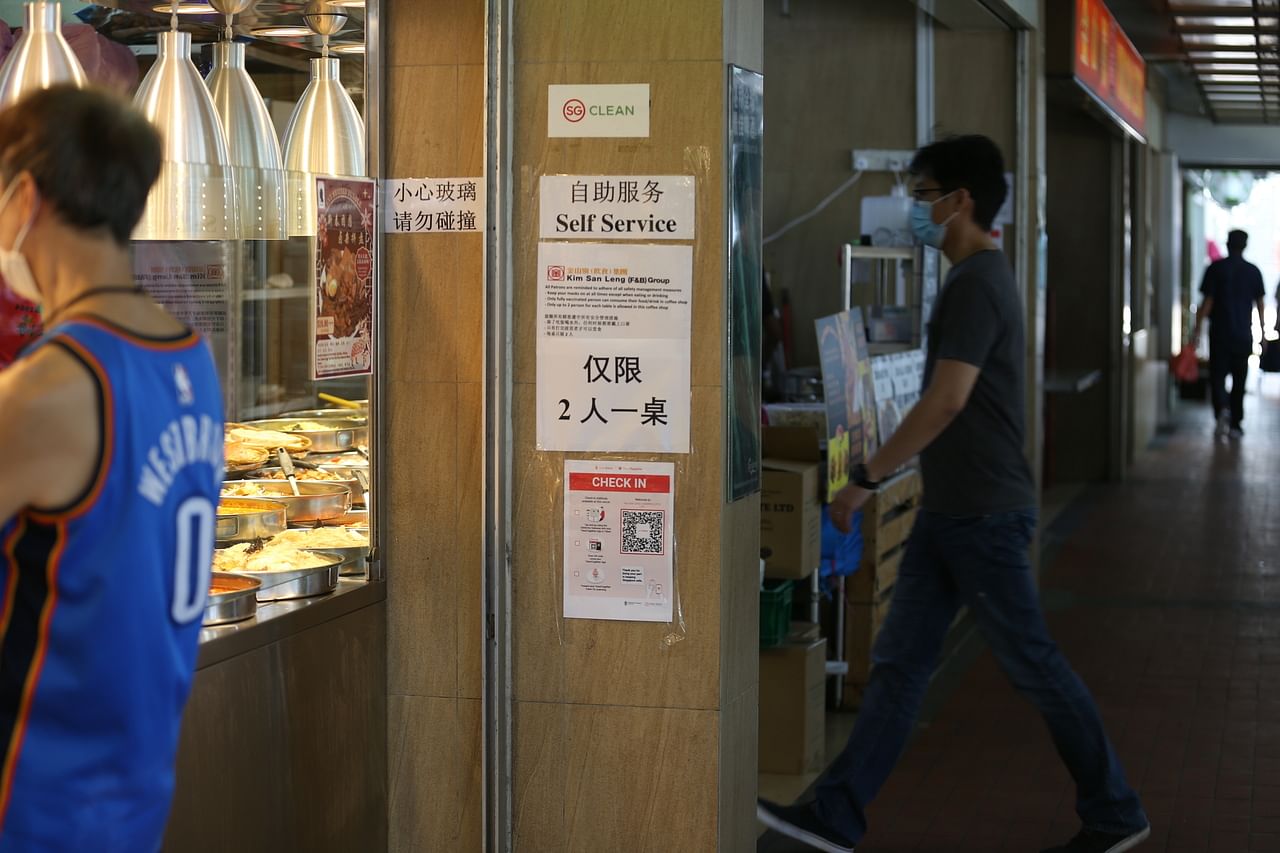
A sign stating that only two people are allowed to dine in at Kim San Leng coffee shop in Tampines. ST PHOTO: SAMUEL ANG
With the additional cost being too much to bear, most operators have decided to wait and see if they can hold out, said Mr Lee.
But coffee shops that stick to allowing dining for only two people also have to grapple with slower business, with diners preferring to go to eateries where they can sit in larger groups.
Ms Hasria Hashim, who sells Malay food at Kim San Leng coffee shop in Tampines, said she has seen a 40 per cent drop in customers compared with when larger groups were allowed.
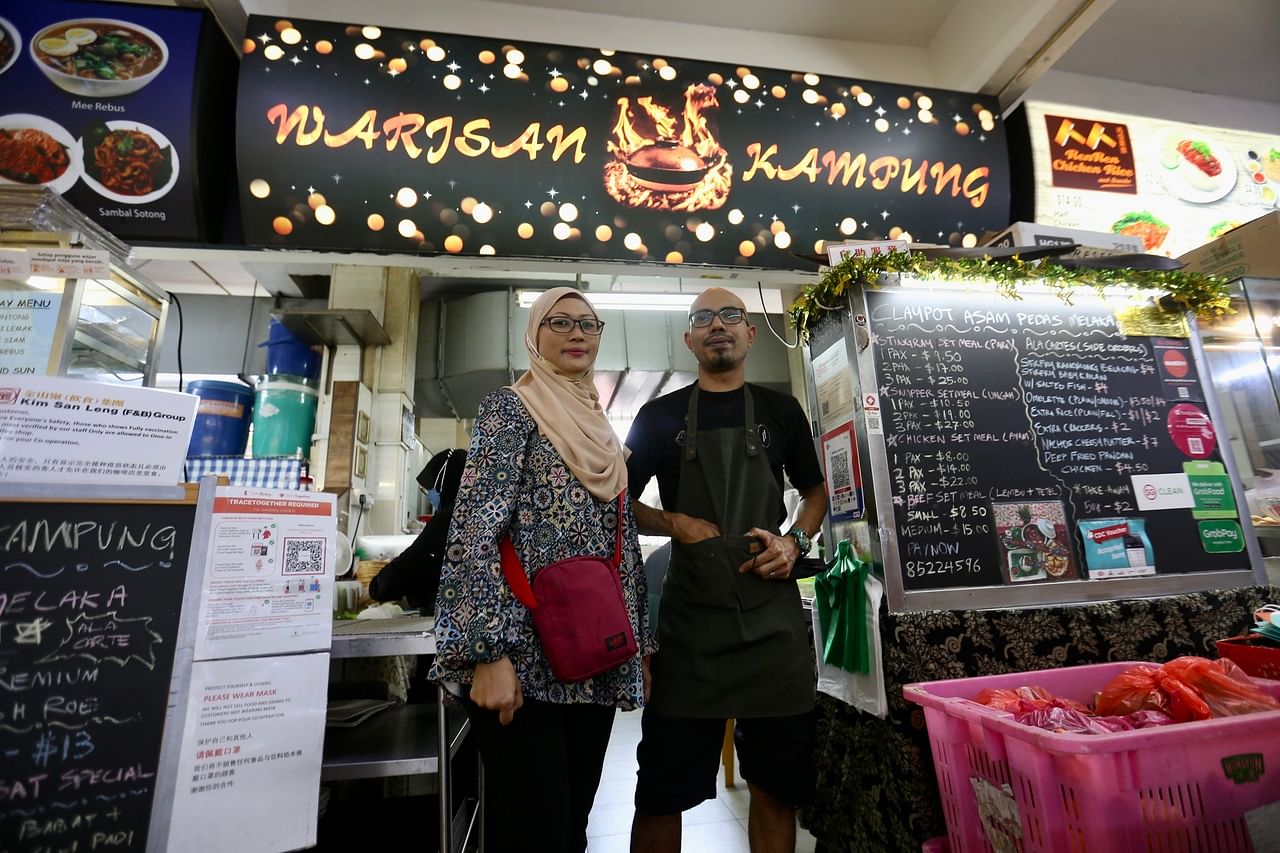
Ms Hasria Hashim and her partner at their stall. ST PHOTO: SAMUEL ANG
Competition is tough as there are other coffee shops, and the nearby Tampines Round Market and Food Centre allows groups of five to sit together, she said.
"We felt that it is unfair because not all coffee shops have the manpower. Many people are vaccinated, so I don't see an issue with our coffee shop allowing five people to dine in together."
Some stallholders also have to remind patrons to abide by the rules.
Ms Huang Ya Dong, a drink stall assistant at a coffee shop in Toa Payoh, said she has come across unhappy and difficult customers who do not want to follow the rules.
"There are some difficult customers who would tell us, 'Do you expect me to sit on the floor?' when we ask them to seat no more than two per table. We usually have to explain the regulations to them again, mention the fines they would incur, and take photos of them if needed."
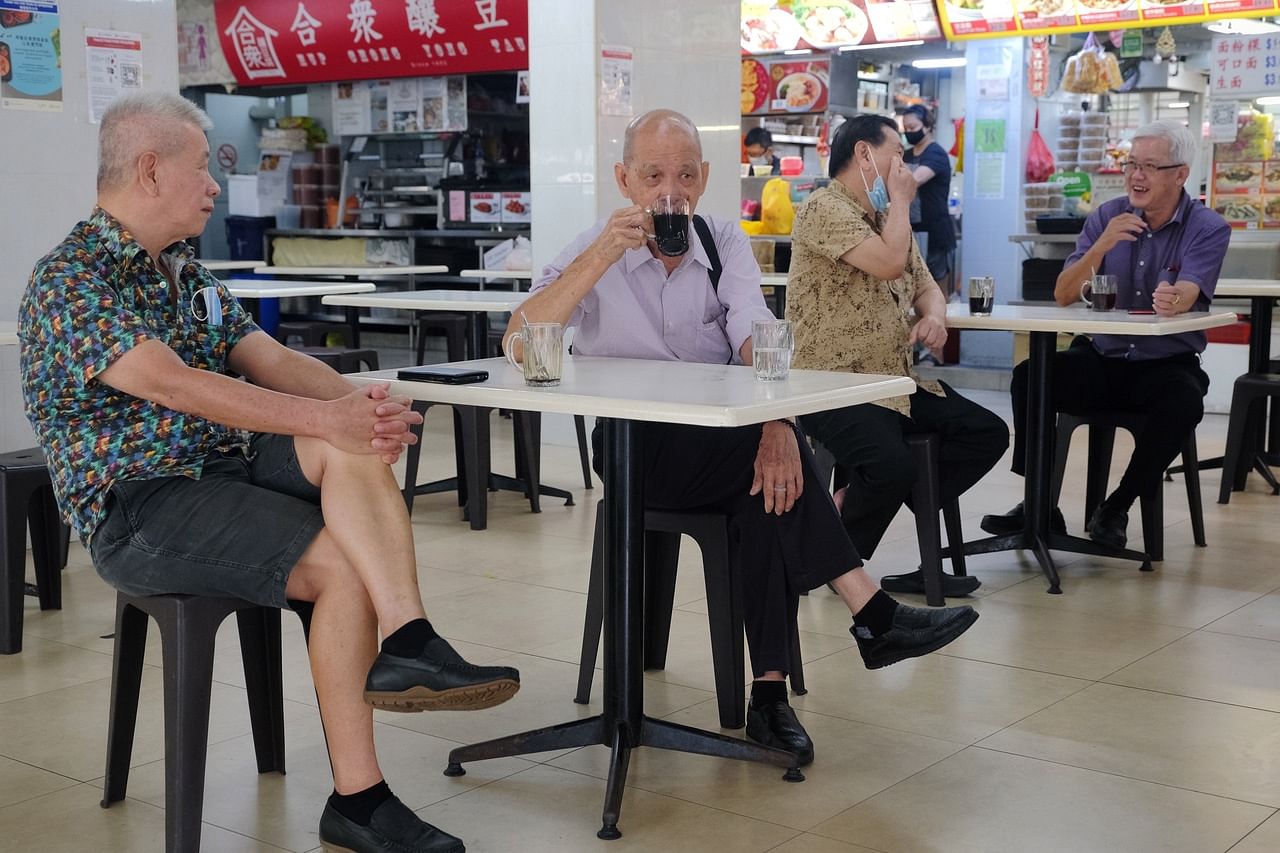
Diners at Hai Fong coffee shop in Toa Payoh on Jan 14, 2022. The coffee shop allows dining for only two people. ST PHOTO: THADDEUS ANG
The Singapore Food Agency said that private operators, coffee shops and canteen operators can decide if they want to implement the required measures to allow larger groups to dine in, but noted that some may not choose to do so due to difficulties.
It added that it will continue to assist coffee shops and canteens when required, such as by giving advice to operators who are unsure of how to implement the measures.
- Joined
- Jul 25, 2008
- Messages
- 13,602
- Points
- 113
MOH investigating death of 103-year-old who was erroneously given 4th Covid-19 jab
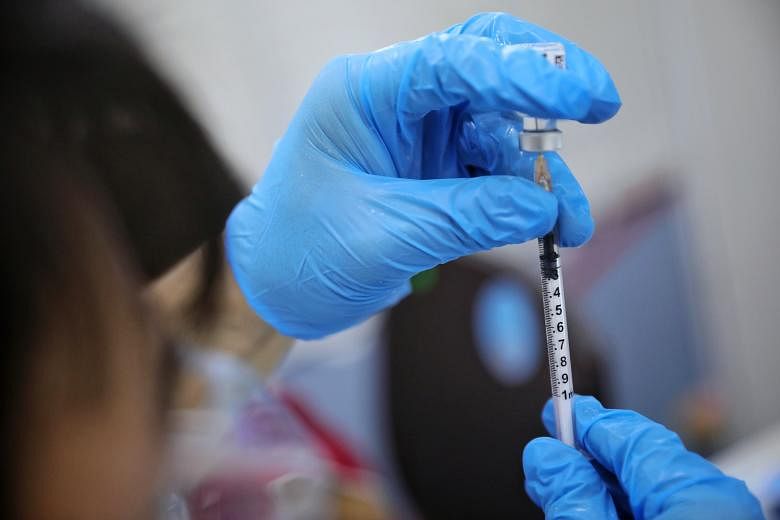
MOH said it takes a serious view of the incident and is carrying out a thorough investigation. ST PHOTO: KEVIN LIM

Linette Lai
Health Correspondent
Feb 4, 2022
SINGAPORE - The Health Ministry (MOH) is investigating the death of a 103-year-old woman who was erroneously given a fourth dose of the Covid-19 vaccine by a mobile vaccination team.
The woman, a nursing home resident, was admitted to Changi General Hospital on Dec 16 - three days after receiving the extra dose.
She had pneumonia and low sodium levels, and was subsequently diagnosed as having had a stroke.
The woman died on Jan 10.
An autopsy found that the main cause of death was pneumonia, with other contributing factors including stroke and coronary artery disease. The coroner has not determined if these were linked to vaccination.
However, these are natural disease processes common in seniors, said MOH in a statement on Friday (Feb 4).
MOH said it takes a serious view of the incident and is carrying out a thorough investigation, which is likely to be completed this month.
"Our preliminary findings were that the vaccine was erroneously administered due to possible irregularities in vaccination procedures and poor communication between the nursing home and the medical service provider handling the vaccination," it said.
The woman was a resident at Econ Healthcare's Chai Chee nursing home, while the vaccination was administered by a team from PanCare Medical Clinic. Both have co-funded the woman's hospital bill as a gesture of goodwill, MOH said.
The ministry added that this is the first case of mistaken identity leading to erroneous vaccination by a mobile vaccination team.
Some 152,000 such mobile vaccinations have been carried out to date.
It added that it had originally planned to announce the incident in December.
However, the woman's family had requested to withhold details which could have led to her identification.
"We have since consulted the family further and are releasing the information to provide clarity on the incident."
Both the nursing home and the mobile vaccination provider have reviewed their processes to prevent such an incident from recurring.
The Agency for Integrated Care, which facilitates vaccinations in nursing homes, has also reminded the homes to ensure proper communication with mobile vaccination teams.
"MOH has also reminded all mobile vaccination teams to perform independent identity verification and authentication before administering any vaccination," the ministry said.
- Joined
- Jul 25, 2008
- Messages
- 13,602
- Points
- 113
Forum: SafeEntry stickers often serve no purpose
PUBLISHED
Feb 8, 2022
A cartoon by Straits Times artist Miel published on Jan 23 succinctly captured an observation that has been made by many.
The vaccination status stickers issued during SafeEntry check-ins at hawker centres serve no purpose as no one checks them.
These stickers are then haphazardly disposed of everywhere within the hawker centres. Sticker boards have not solved the problem. The stickers end up on pillars, bus stops and lamp posts.
They are an eyesore, and unnecessarily burden the cleaners who have to remove them.
Why is there the perplexing insistence on issuing stickers?
Tan Khee Shian
- Joined
- Jul 25, 2008
- Messages
- 13,602
- Points
- 113
Forum: Bus stop benches not senior-friendly
Feb 15, 2022Many benches at bus stops are built very low to the ground.
This makes it inconvenient for the elderly to get up from them, especially seniors with knee problems or stiff joints.
At some stops, benches are tall enough, but they slant to the front, making them uncomfortable to sit on.
I hope the authorities will consider those issues in making bus stops more senior-friendly.
Oei Khoen Hwa
- Joined
- Jul 25, 2008
- Messages
- 13,602
- Points
- 113
Forum: Allow self-reported ART positive results to be officially recorded
FEB 16, 2022
As a general practitioner (GP) battling the current wave of Omicron infections, I am glad that the majority of low-risk, fully vaccinated infected persons have minor symptoms and recover well.
However, due to the sheer numbers daily, I find myself bogged down by having to re-administer antigen rapid tests (ARTs) and complete administrative tasks to reconfirm mild cases who test positive at home, so that the positive result can be officially recorded.
Currently, having an official record of infection removes the need for a booster shot within a certain period to maintain the fully vaccinated status, allows care under the Home Recovery Programme for low-risk persons, and gives public healthcare institutions precise knowledge of a person's infection status.
Therefore, I applaud the move by the Ministry of Health (MOH) to allow patients with mild symptoms to get their result verified at a nearby test centre (Covid-19 patients with mild symptoms can get results certified for free at test centres, instead of GPs, Feb 15).
While its by-appointment-only system allows for crowd control and minimal waiting time, MOH must ensure adequate slots so that patients can get verified on day one of infection, and avoid further travel to another centre or ending up visiting a GP or polyclinic.
Remote tele-supervised ART testing ought to be extended by these centres to prevent infected persons from leaving their home.
Pharmacists may also be stationed to dispense pharmacy-only basic medications for symptoms such as fever, runny nose, cough and sore throat.
In addition to uploading the results onto patients' HealthHub records, centres should consider providing an official document with wording which can serve as both medical certificates (for employers who still require them) and proof of time-based recovery.
Preserving primary healthcare capacity is just as important as preserving hospital capacity.
Long waiting times at clinics and over-burdened GPs may detract from chronic disease care, and create a spillover effect as patients may choose to visit hospital accident and emergency departments for simple ailments.
Furthermore, having a crowd of patients at cramped clinic waiting areas puts non-infected or vulnerable patients at risk of catching the virus.
I hope MOH can in future consider allowing self-reported ART positive results to be officially recorded for low-risk and fully vaccinated individuals.
Such a move would be in line with the current simplified healthcare protocols that emphasise personal responsibility in self-testing and isolation.
Firm measures can be put in place to deter false declarations.
Roger Teo Chee Yih (Dr)
- Joined
- Jul 25, 2008
- Messages
- 13,602
- Points
- 113
The government revised the numbers. Do you still believe in the statistics given by the government?
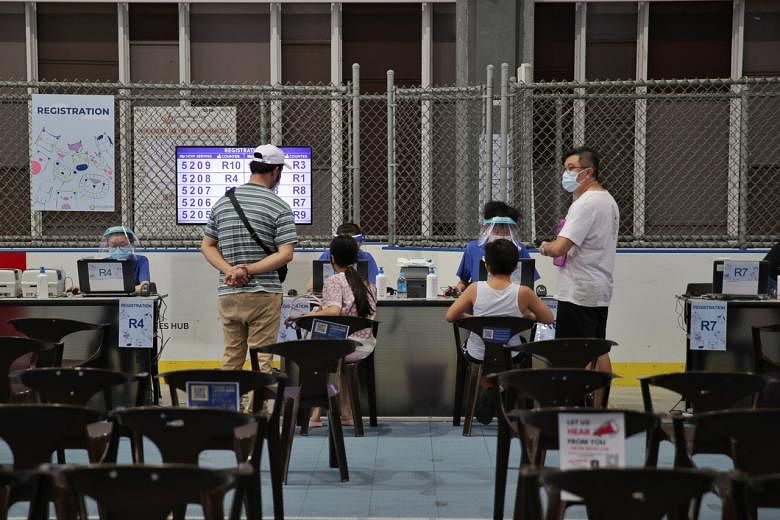
There have been no cases of myocarditis or pericarditis among children so far, HSA said. ST PHOTO: GIN TAY

Linette Lai
Health Correspondent
Feb 23, 2022
SINGAPORE - Singapore has seen 10 cases of children aged five to 11 with serious side effects after vaccination, out of a total of 238,253 doses administered to this age group as at Jan 31, said the Health Sciences Authority (HSA) in its latest vaccine safety update on Wednesday (Feb 23).
This departs from its previous update, in which no such cases were reported. But HSA said the incidence rate – of 0.004 per cent – is similar to what has been seen among teenagers and adults.
Serious side effects include seizures, appendicitis, drops in blood pressure, allergic reactions, abnormal kidney function and swelling of small blood vessels.
There have been no cases of myocarditis or pericarditis - two heart-related conditions sometimes reported after vaccination - among children so far, HSA said.
In Wednesday's update, which covers events up to Jan 31, HSA also said 280 cases of non-serious side effects have been reported in this age group, compared with six previously.
Also similar to the incidence rate seen among teenagers and adults, non-serious reactions occur in 0.12 per cent of doses administered to children aged five to 11.
Such side effects reported among children include facial swelling, fever, rash, chest discomfort, palpitations and shortness of breath.
Incidence rates are similar to what has been seen among teenagers and adults, with non-serious reactions occurring in 0.12 per cent of doses administered, and serious reactions seen in 0.004 per cent of doses.
Singapore rolled out its Covid-19 vaccination programme for children aged five to 11 on Dec 27 last year. A total of 238,253 doses had been administered to this age group as at Jan 31.
HSA said vaccination may not have been the cause of medical problems in every case. "They may be related to an underlying or undiagnosed disease, or it may be coincidental that they occurred around the same time that the vaccine was given."
The HSA report also gave an update on booster doses, noting that there has been no increase in the frequency of side effects following more than 3.19 million booster jabs administered.
The agency had received 553 adverse event reports linked to booster shots of the Pfizer-BioNTech/Comirnaty vaccine, and another 289 reports linked to the Moderna/Spikevax vaccine.
There were 73 reports of severe side effects, of which 15 cases were myocarditis and pericarditis.
As at end-January, Singapore has administered 9.8 million doses of the Pfizer vaccine. There were 12,770 reports of non-serious side effects and 664 serious ones.
The country also administered 2.9 million doses of the Moderna vaccine, with 2,885 reports of non-serious side effects and 156 serious ones.
The report also gave an update on non-mRNA jabs, such as the Sinovac-CoronaVac and Sinopharm vaccines.
Singapore has administered 369,083 doses of the Sinovac vaccine to date. There were 299 reports of non-serious side effects and 22 serious ones.
It has also administered 89,350 doses of the Sinopharm vaccine, with 41 reports of non-serious side effects and six serious ones.
HSA said it is not possible to directly compare reports of side effects for different vaccines.
"The vaccines may have been used in the vaccination programme for different lengths of time, and may have been administered to different numbers of people with different underlying medical conditions and across different settings," it said.
The authority also noted that mRNA vaccines have resulted in a small increase in the baseline incidence of cerebral venous thrombosis (CVT) in the local population. This is a condition where blood clots are found in the veins of the brain.
The increase translates to about one additional case of CVT per million doses, it said.
However, the authority also pointed out that Covid-19 infection can also result in CVT. In Singapore, the additional number of CVT cases associated with infection is about 30 per million infected people.
"Considering that the risk of CVT after Covid-19 infection is much higher than CVT after mRNA vaccination, the benefits of vaccination continue to outweigh the small increased incidence of CVT," HSA said.
10 cases of more than 200,000 children with serious side effects after Covid-19 jab: HSA

There have been no cases of myocarditis or pericarditis among children so far, HSA said. ST PHOTO: GIN TAY

Linette Lai
Health Correspondent
Feb 23, 2022
SINGAPORE - Singapore has seen 10 cases of children aged five to 11 with serious side effects after vaccination, out of a total of 238,253 doses administered to this age group as at Jan 31, said the Health Sciences Authority (HSA) in its latest vaccine safety update on Wednesday (Feb 23).
This departs from its previous update, in which no such cases were reported. But HSA said the incidence rate – of 0.004 per cent – is similar to what has been seen among teenagers and adults.
Serious side effects include seizures, appendicitis, drops in blood pressure, allergic reactions, abnormal kidney function and swelling of small blood vessels.
There have been no cases of myocarditis or pericarditis - two heart-related conditions sometimes reported after vaccination - among children so far, HSA said.
In Wednesday's update, which covers events up to Jan 31, HSA also said 280 cases of non-serious side effects have been reported in this age group, compared with six previously.
Also similar to the incidence rate seen among teenagers and adults, non-serious reactions occur in 0.12 per cent of doses administered to children aged five to 11.
Such side effects reported among children include facial swelling, fever, rash, chest discomfort, palpitations and shortness of breath.
Incidence rates are similar to what has been seen among teenagers and adults, with non-serious reactions occurring in 0.12 per cent of doses administered, and serious reactions seen in 0.004 per cent of doses.
Singapore rolled out its Covid-19 vaccination programme for children aged five to 11 on Dec 27 last year. A total of 238,253 doses had been administered to this age group as at Jan 31.
HSA said vaccination may not have been the cause of medical problems in every case. "They may be related to an underlying or undiagnosed disease, or it may be coincidental that they occurred around the same time that the vaccine was given."
The HSA report also gave an update on booster doses, noting that there has been no increase in the frequency of side effects following more than 3.19 million booster jabs administered.
The agency had received 553 adverse event reports linked to booster shots of the Pfizer-BioNTech/Comirnaty vaccine, and another 289 reports linked to the Moderna/Spikevax vaccine.
There were 73 reports of severe side effects, of which 15 cases were myocarditis and pericarditis.
As at end-January, Singapore has administered 9.8 million doses of the Pfizer vaccine. There were 12,770 reports of non-serious side effects and 664 serious ones.
The country also administered 2.9 million doses of the Moderna vaccine, with 2,885 reports of non-serious side effects and 156 serious ones.
The report also gave an update on non-mRNA jabs, such as the Sinovac-CoronaVac and Sinopharm vaccines.
Singapore has administered 369,083 doses of the Sinovac vaccine to date. There were 299 reports of non-serious side effects and 22 serious ones.
It has also administered 89,350 doses of the Sinopharm vaccine, with 41 reports of non-serious side effects and six serious ones.
HSA said it is not possible to directly compare reports of side effects for different vaccines.
"The vaccines may have been used in the vaccination programme for different lengths of time, and may have been administered to different numbers of people with different underlying medical conditions and across different settings," it said.
The authority also noted that mRNA vaccines have resulted in a small increase in the baseline incidence of cerebral venous thrombosis (CVT) in the local population. This is a condition where blood clots are found in the veins of the brain.
The increase translates to about one additional case of CVT per million doses, it said.
However, the authority also pointed out that Covid-19 infection can also result in CVT. In Singapore, the additional number of CVT cases associated with infection is about 30 per million infected people.
"Considering that the risk of CVT after Covid-19 infection is much higher than CVT after mRNA vaccination, the benefits of vaccination continue to outweigh the small increased incidence of CVT," HSA said.
- Joined
- Jul 25, 2008
- Messages
- 13,602
- Points
- 113
Forum: Uncertified absenteeism can affect companies' operations
Feb 25, 2022Manpower Minister Tan See Leng appealed to employers to not request medical certificates from workers who test positive for Covid-19 (No need to ask employees with Covid-19 for medical certificate: Tan See Leng, Feb 23).
I appreciate that this is so as not to overload the already strained healthcare system. But how is this to work?
Is it sufficient for the employee to call up and declare that he has Covid-19? Should he send a photo of the positive antigen rapid test immediately or when he returns to work? Will an employer readily accept this? It is not easy to have such complete faith.
But there is another issue: the crippling effect on an employer's operations if he allows such uncertified absenteeism.
It is through a rigorous system of granting approval for those who are genuinely sick to take leave that an employer can sustain his operations.
J.A. Bragassam
- Joined
- Jul 25, 2008
- Messages
- 13,602
- Points
- 113
Forum: Whether an MC is needed to be excused from school is a grey area
FEB 26, 2022I refer to the article, "No need to ask employees with Covid-19 for medical certificate: Tan See Leng" (Feb 23).
Manpower Minister Tan See Leng appealed to employers to not request medical certificates from workers who test positive for Covid-19.
Does this advisory apply to schools?
From what I understand, a medical certificate (MC) is necessary as long as the student is absent from school.
What happens if a student who previously tested positive then tests negative, but has minor symptoms like a runny nose - does he need to produce an MC to stay away from school?
When I asked my children's teachers on the exact protocol to follow, the most common response was: "I am not sure, because the rules keep changing. The safest thing to do is to just go and get the MC."
This is a grey area the authorities need to clarify.
Alex Yeo
- Joined
- Jul 25, 2008
- Messages
- 13,602
- Points
- 113
Forum: Review implementation of SafeEntry check-ins at hawker centres
APR 15, 2022
I am confused by why SafeEntry check-in is implemented in some hawker centres and not others.
I was asked to do a SafeEntry check-in at Maxwell Food Centre recently. When I crossed over to Chinatown Complex Food Centre, there was no need to check in.
At Newton Food Centre, the barricades have been removed. Only one entry is manned by safety ambassadors who insist that people do a SafeEntry check-in. Meanwhile people can just walk in via the other entry points without checking in.
At Old Airport Road Food Centre, there is an unmanned table where a SafeEntry check-in device is placed. The other entry points have no such device.
I hope the authorities can review the implementation criteria for SafeEntry check-in to avoid confusion.
Foo Sing Kheng
- Joined
- Jul 25, 2008
- Messages
- 13,602
- Points
- 113
Forum: With masks now optional, what other protective measures are in place in schools?
Aug 25, 2022I refer to the announcement that masks are optional indoors from Aug 29 except on public transport and healthcare settings.
As a parent, I would like to ask what other measures schools have in place to protect school children from infection, especially those taking the approaching national examinations. For example, would children who wish to still wear masks be allowed to do so without penalty?
The year-end national examinations like the Primary School Leaving Examination (end-September), O levels (mid-October) and A levels (early November) are approaching.
With daily Covid-19 infection rates still in the thousands, it is likely that infection rates in Singapore will rise further after the relaxation of measures for a short period, which would carry on into the examination period.
To be unable to go to school to take a national examination because of a Covid-19 infection could stress a student. Even if provisions are made to allow the student to take the examination at home or isolated at school, doing the exam while ill would not allow the student to perform at his best.
Therefore, preventing infection is still the best way for the next few months until the examinations are over.
I hope the education authorities will clarify how schools will balance the relaxation of mask-wearing requirements with the need to protect those who are about to take national exams.
Alex Yeo
- Joined
- Jul 25, 2008
- Messages
- 13,602
- Points
- 113
Taxi and private-hire drivers surprised at change in mask-wearing rule, worried about Covid-19 transmission
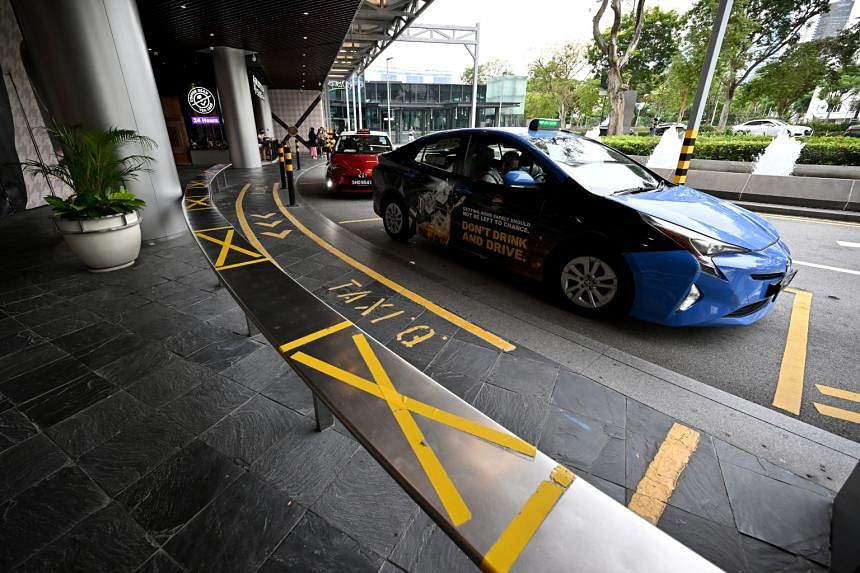
Drivers surveyed said making masks optional in such a confined space increases the risk of Covid-19 transmission. ST PHOTO: LIM YAOHUI

Clement Yong
Aug 25, 2022
SINGAPORE - Taxi driver Thomas Lim was taken aback when he learnt on Wednesday (Aug 24) that mask-wearing will no longer be compulsory on taxis and private-hire car rides from next Monday.
He had heard that the Government would remove indoor masking requirements in most settings, but thought transport settings such as taxis would be the last place where mask rules would change.
"I don't support it at all," he said, noting that passengers will be in a small, enclosed area for an extended period of time. "It is very bad for drivers."
The 51-year-old is among taxi and private-hire drivers who are unhappy with the impending change in mask rules. They said making masks optional in such a confined space increases the risk of Covid-19 transmission, noting that they can ferry more than 20 passengers a day.
Mr Lim said his immunity has been compromised after he contracted Covid-19 last month, adding that he still suffers from a cough and sore throat.
He is very concerned about reinfection. "I will let passengers know I prefer that they wear a mask," he said. "If they are coughing or sneezing, I'll wind down the windows to increase ventilation, but there's not much else I can do."
Other drivers said the new rule could also become a potential cause of conflict if some drivers insist that their passengers wear a mask.
In an advisory on its Facebook page, the Land Transport Authority encouraged drivers and passengers to continue wearing masks to protect one another.
Ride-hailing operators Gojek and Grab echoed this call, saying drivers and passengers should mask up if they feel unwell. Grab also advised its drivers to wind down windows to improve ventilation if passengers are agreeable. However, drivers interviewed felt that many passengers will not heed this call.
Strides driver Sherwin Tan, 40, said some passengers have already stopped wearing their masks in recent months, especially at night when he picks them up from areas such as Marina Bay Sands and Resorts World Sentosa.
In the early days of the pandemic, he said he would have insisted that they wear a mask. "We close one eye now. Many people have already gotten their booster shots and most have already gotten Covid-19. Not wearing masks lets passengers feel more relaxed."
Mr Tan added that he will spray disinfectant on the car seats after dropping off each passenger, and keep his mask on to protect himself.
Cabby Ethan Ong, 38, said the Government should have left it up to drivers to decide whether their passengers should have to wear a mask.
"It creates conflict, doesn't it? Many drivers are quite kiasi (scared of dying), so what happens if they tell the passengers to wear a mask and they refuse? What then?"
With the changes, drivers cannot refuse passengers who are not masked, The Straits Times understands.
Can a taxi driver ask me to mask up? Do I need to wear a mask at a concert?
Masks optional on taxis and in most indoor settings from Monday: 7 things you need to know
Pasir Ris-Punggol GRC MP Yeo Wan Ling, adviser to the National Taxi Association and the National Private Hire Vehicles Association, asked the public to be considerate and requested that taxi companies and private-hire platforms keep supporting drivers who fall ill.
"Unlike employees, our drivers lose income for every day they do not drive, should they be infected with Covid-19, and they would still need to pay for daily rentals and other incidentals, even if they are not on the road," Ms Yeo said.
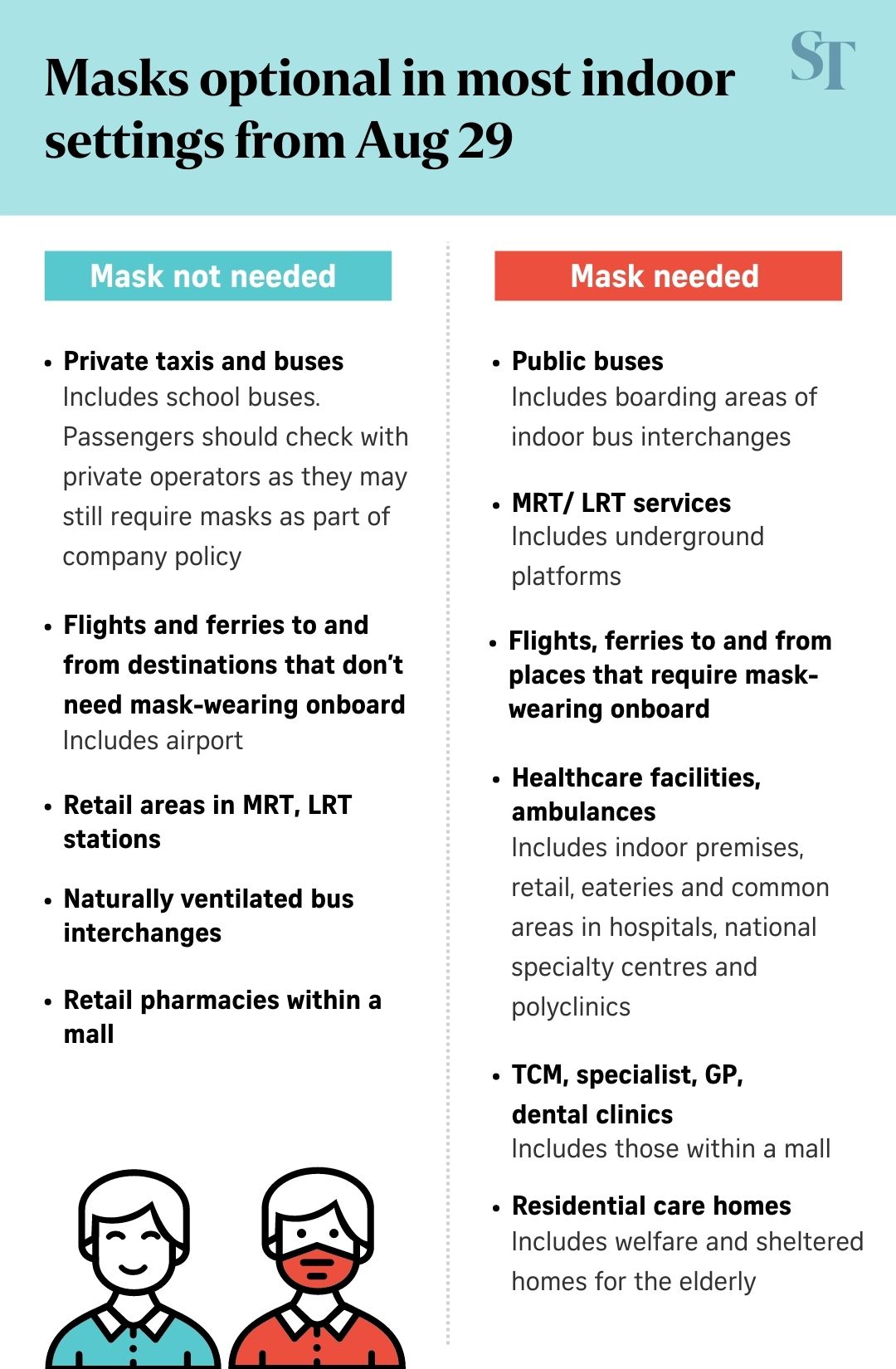
Lawyer Yap Shikai, 27, said he does not intend to wear a mask while taking point-to-point trips unless he feels unwell, but will put it on if the driver asks him to.
"It's a prudent move to keep the mask-wearing rule for public transport," he added. "It can get quite crowded during rush hour. At least my ride won't be ruined by someone spreading germs or by someone's stale breath."
- Joined
- Jul 25, 2008
- Messages
- 13,602
- Points
- 113
Forum: Healthcare staff had to manage patients and backlog after Covid-19 waves
Aug 27, 2022The current Covid-19 wave may appear to have eased to some extent, both globally and locally, but many people are still cautious when they go about their daily lives and when travelling.
Many still prefer to wear masks while in public places because they realise that being infected with Covid-19 affects not just them but also their family and colleagues.
At the height of every Covid-19 wave, healthcare workers were stretched to the extreme to manage the infected patients. Extra assistance from non-clinical departments was needed to help ease the workload.
Outpatient appointments and other non-urgent cases were often postponed, which meant that when each infection wave passed, healthcare workers were busy clearing this backlog of non-Covid-19 patients.
In many hospitals, beds are still in short supply.
Based on feedback from patients and doctors, many patients are still facing a longer-than-usual waiting time for investigations and follow-up, although the situation may not be as bad as during the height of the pandemic.
Hence, I was puzzled to read that experts said Singapore went through the two Covid-19 Omicron waves without its healthcare system being overwhelmed (Masks not needed in most situations as S'pore becomes Covid-19 resilient: Experts, Aug 22).
Perhaps this definition of an "overwhelmed" healthcare system is based on statistical modelling. The on-the-ground experience at hospitals, especially departments on the front line like the accident and emergency units, would have been different.
Healthcare workers who experienced stress and fatigue, and made sacrifices to fulfil their duties to care for patients would have seen the system as being overwhelmed.
Ho Ting Fei (Dr)
Similar threads
- Replies
- 16
- Views
- 961
- Replies
- 28
- Views
- 1K
- Replies
- 10
- Views
- 530
- Replies
- 58
- Views
- 2K
